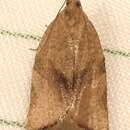en
names in breadcrumbs


Argyrotaenia franciscana, the orange tortrix or apple skinworm, is a moth of the family Tortricidae. It is found from California north to Oregon and Washington.[2]
The length of the forewings is 5.6-9.9 mm. There are at least two, but sometimes more generations per year.
The larvae feed on a wide range of nearly 80 plants, including Malus, Prunus armeniaca, Persea americana, Rubus, Vaccinium, Vitis, Citrus x paradisi, Citrus limon and Pinus radiata. Early instar larvae skeletonize leaves under a silk shelter, while later instars roll, fold, or web leaves together or to fruits. Either the larvae or pupae overwinter. Overwintering can take place in dead leaves, mummified fruits, under buds or on weedy herbaceous plants near the host. Pupation occurs in the final larval shelter.
![]() Data related to Argyrotaenia franciscana at Wikispecies
Data related to Argyrotaenia franciscana at Wikispecies
Argyrotaenia franciscana, the orange tortrix or apple skinworm, is a moth of the family Tortricidae. It is found from California north to Oregon and Washington.
The length of the forewings is 5.6-9.9 mm. There are at least two, but sometimes more generations per year.
The larvae feed on a wide range of nearly 80 plants, including Malus, Prunus armeniaca, Persea americana, Rubus, Vaccinium, Vitis, Citrus x paradisi, Citrus limon and Pinus radiata. Early instar larvae skeletonize leaves under a silk shelter, while later instars roll, fold, or web leaves together or to fruits. Either the larvae or pupae overwinter. Overwintering can take place in dead leaves, mummified fruits, under buds or on weedy herbaceous plants near the host. Pupation occurs in the final larval shelter.